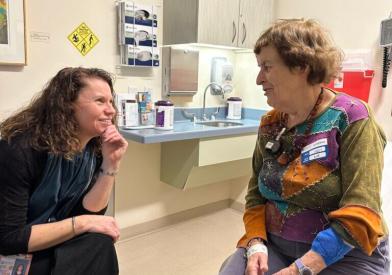Stages of Breast Cancer
We provide personalized treatment plans based on you, your needs, and your specific type of cancer. Current research and care focuses on the four major subtypes of breast cancer. Lab analysis can determine which subtype of breast cancer you have:
Ductal Carcinoma in Situ (DCIS)
Also known as pre-invasive breast cancer, DCIS is very treatable and highly curable. In DCIS, abnormal cells are found in the lining of a breast duct but have not spread outside the duct to other tissues in the breast.
DCIS is diagnosed in nearly 60,000 women in the United States each year, a significant increase over previous decades, due to the widespread use of digital mammograms and MRIs, which detect DCIS at a smaller, earlier stage. When surgically removed with lumpectomy and usually followed by radiation or a mastectomy with reconstruction, the disease is nearly always curable.
Research from Dana-Farber Brigham Cancer Center scientists may lead to screening tests to better understand whether some patients with DCIS might be able to safely receive less treatment and which patients might benefit from more aggressive treatment.
Learn more about our specialized Ductal Carcinoma in Situ (DCIS) Program.
Invasive Breast Cancer
Invasive cancers have started to break through normal breast tissue barriers and have the potential to spread to lymph nodes or other parts of the body. There are nearly 233,000 new cases of invasive breast cancer in women each year.
Biologically, breast cancer is not a single disease but actually several different diseases, which can act differently depending on their distinctive genetic makeup. Invasive breast cancer is categorized as stage I, II, III, or IV, depending on the amount and location of cancer in the body. Treatment plans for any stage of breast cancer include a multidisciplinary approach, and may include surgery, radiation therapy, chemotherapy/endocrine therapy, and/or targeted biologic therapy, such as trastuzumab.
Inflammatory Breast Cancer
With inflammatory breast cancer (IBC), cancer cells block the lymph vessels of the skin of the breast, causing the breast to appear red or inflamed. Unlike other types of breast cancer, IBC generally does not present with a lump.
If you experience any of these symptoms, contact your physician immediately. IBC is typically diagnosed through a clinical exam, and confirmed with a breast biopsy. Prompt and accurate diagnosis and treatment is important because of the aggressive nature of the disease. The treatment starts with systemic therapy (chemotherapy and targeted therapy), followed by surgery and then radiation therapy.
Learn more about our specialized Inflammatory Breast Cancer Program.
At the Susan F. Smith Center for Women's Cancers Breast Oncology Program, at Dana-Farber Brigham Cancer Center, our team of experts work together to provide compassionate and comprehensive care for patients with breast cancer. We are committed to providing every patient with the best and most personalized treatment options available, taking advantage of the full range of services of a top-ranked cancer hospital and research center.
We provide comprehensive services to patients with these cancers, including:
- Personalized treatment plans based on your needs and the details of your specific cancer, along with the latest and most advanced care possible
- Tissue-preserving procedures and precise surgical and radiation therapy techniques that provide the best results possible. We also are leaders in breast reconstruction.
- Specialty care designed specifically for young adults with breast cancer, women with inflammatory breast cancer, and women with hereditary breast cancer. These are model programs being replicated around the country.
- Expert symptom management teams to help you feel better throughout your treatment
- Genetic evaluation for patients who have a personal or family history that suggests an inherited risk of or tendency to develop breast cancer
- Access to social workers, psychiatry, integrative therapies, pain specialists, nutritionists and exercise physiologists
- Access to fertility specialists who have unique expertise in providing care to women who are battling cancer and have concerns about future fertility
- Access to clinical trials available for all stages and subtypes of breast cancer, with an average of 50 clinical trials available at all times for all stages of breast cancer
- Multidisciplinary care delivered by specialists from Dana-Farber Cancer Institute and Brigham and Women’s Hospital









